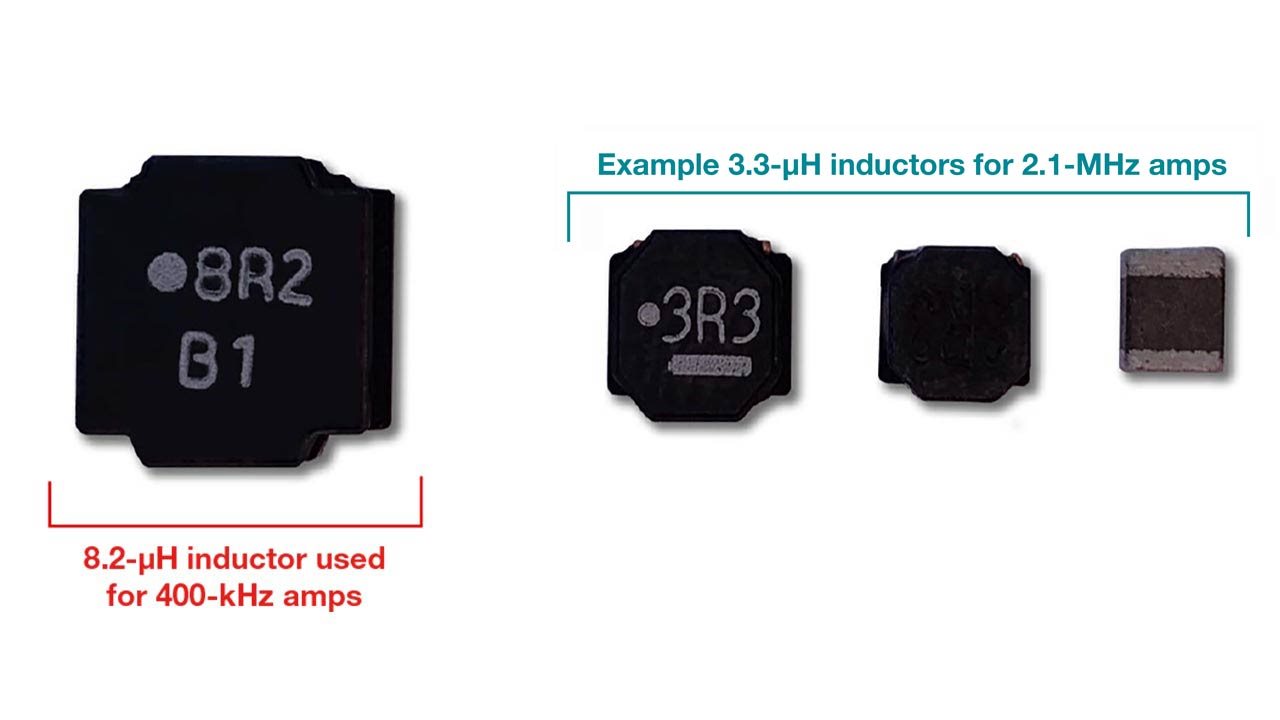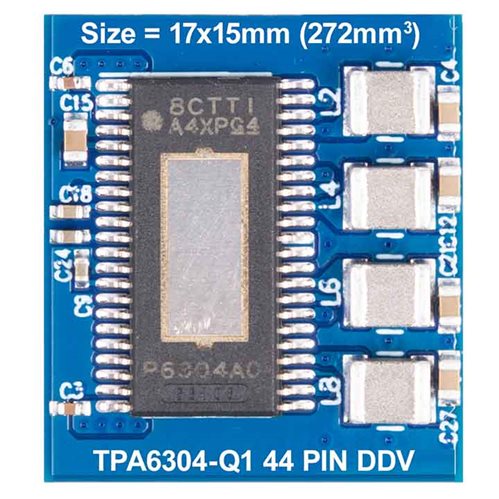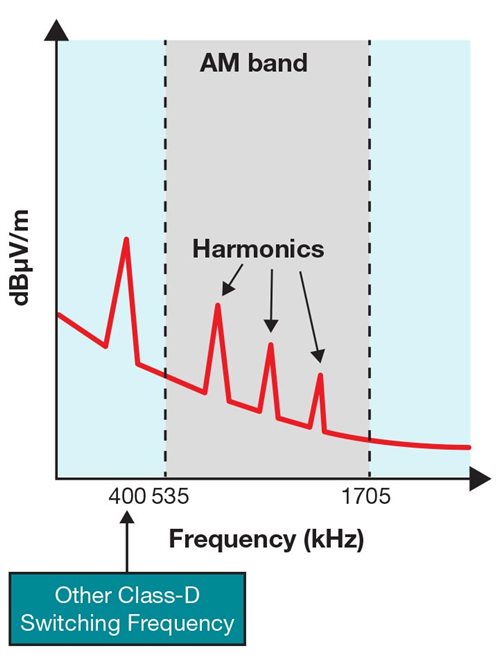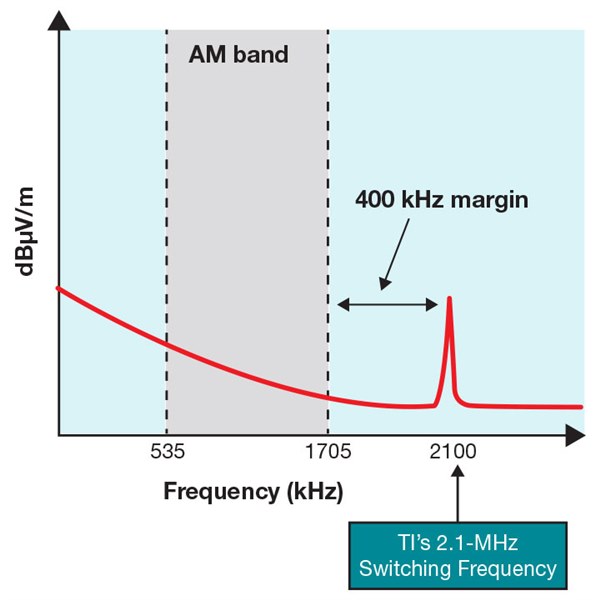SSZT399 october 2019 TPA6304-Q1
Have you ever dreamed of doing something awesome but psyched yourself out, thinking that it was going to be too hard to complete? Then, after you finally got the courage to go for it, you looked back in astonishment – it was really fairly easy.
This is the scenario I’m witnessing lately when speaking with automotive audio design engineers about switching their car radio solution from a traditional Class-AB amplifier to a Class-D amplifier. So let’s talk about the two primary concerns that I hear about most often: the impact on printed circuit board (PCB) size and potential electromagnetic interference (EMI) concerns.
Concern No. 1: Class-D Amplifiers Are Going to Enlarge Your PCB Footprint
Typical Class-D audio amplifiers switch the amplifier on and off at ~400 kHz and require the use of 8.2-µH or 10-µH inductors for proper audio performance.
 Figure 1 Comparison of Inductor Size vs. Switching Frequency
Figure 1 Comparison of Inductor Size vs. Switching FrequencyThe TPA6304-Q1 is designed with TI’s latest mixed-signal manufacturing technology, which when coupled with the use of 3.3-µH Inductors shrinks the overall size of the complete four-channel amplifier solution (including all required passive components) to 272 mm2, as shown in Figure 2.
 Figure 2 The TPA6304-Q1 Four-channel Class-D Amplifier
Figure 2 The TPA6304-Q1 Four-channel Class-D AmplifierTo put this into perspective, Figure 3 shows that the complete TPA6304-Q1 solution is smaller than a traditional Class-AB amplifier by itself.
 Figure 3 TPA6304-Q1 Class-D Amplifier Solution Size Compared to a Class-AB Amplifier
Figure 3 TPA6304-Q1 Class-D Amplifier Solution Size Compared to a Class-AB AmplifierConcern No. 2: Class-D Amplifiers Introduce EMC Issues
By nature, a Class-D audio amplifier switches its output on and off during each cycle of the clock, whereas a Class-AB amplifier does not switch. This does not imply, however, that a Class-D amplifier will introduce unmanageable electromagnetic compatibility (EMC) issues.
- The TPA6304-Q1 device design is highly optimized to manage overall EMC behavior. Also, the 3.3-µH inductors discussed previously are part of the inductor-capacitor (LC) filter, which helps minimize EMC from the high-speed switching transients on the output stages of Class-D amplifiers.
- Traditional Class-D amplifiers that switch in the 400-kHz range create harmonics that lay directly within the AM band, as shown in Figure 4. These harmonics create interfering signals that reduce AM receiver sensitivity, thereby
hindering AM radio station reception. Therefore, some type of EMI avoidance scheme must be implemented on these 400-kHz Class-D amplifier designs to mitigate the effects of these AM band harmonics.
 Figure 4 Typical 400-kHz Class-D Amplifier Harmonics
Figure 4 Typical 400-kHz Class-D Amplifier Harmonics - By operating at a much higher 2.1-MHz switching frequency, the TPA6304-Q1 eliminates the need to implement an EMI avoidance scheme for the AM band because the TPA6304-Q1 amplifier provides significant margin above the AM band. This design is also free of any lower-frequency spikes that would interfere in the AM band, as shown in Figure 5.
 Figure 5 The TPA6304-Q1’S High Switching Frequency above the AM Band
Figure 5 The TPA6304-Q1’S High Switching Frequency above the AM BandIn case some PCB layout designs introduce EMI challenges, the TPA6304-Q1 has implemented a Kilby Labs-developed, proprietary spread-spectrum technique. Figure 6 illustrates how this feature helps spread out a narrowband energy source across a much larger frequency band, thereby reducing the peak energy.
 Figure 6 Spread-spectrum Technology Background
Figure 6 Spread-spectrum Technology BackgroundConclusion
The TPA6304-Q1 2.1-MHz higher-switching-frequency automotive Class-D audio amplifier fulfills industry demands for next-generation car radios and external amplifiers. In addition to reducing the thermal load in systems, the amplifier’s design addresses concerns about PCB size and EMC when transitioning from Class-AB amplifiers to Class-D amplifiers.
Additional Resources
- Download the white paper, Automotive Audio Design Considerations to Minimize Amplifier Size and Thermal Load, for further discussion about the benefits of the TPA6304-Q1 design.
- Request a TPA6304-Q1 evaluation module, as well as the schematics, design files and layout guidance, to kick-start your design.
- Explore additional mid-power audio amplifiers.
- Learn more about TI’s automotive infotainment and cluster solutions.